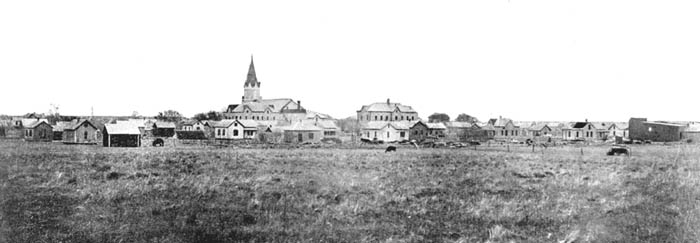
Munjor, Kansas, 1890s.
Munjor, Kansas, is a small unincorporated town in Wheatland Township in south-central Ellis County. A census-designated place, the population was 232 as of the 2020 census.
Another of the many villages settled by German-Russian immigrants, the people first arrived in Herzog (Victoria) in August 1876. The immigrants then established a small village along Big Creek before moving a couple of months later to the present location. They also soon organized the Munjor Land Company, a townsite was surveyed, and each lot holder became a member of the company.
More immigrants joined them over the next couple of years. The residents built the St. Francis Catholic Church — a small frame building in 1877, to which they added on several years later. Then, in September 1881, the tiny community received a post office.
In 1882, the Munjor Land Company was replaced with the Munjor Town and Grazing Company, which required that no portion of the landholdings could be burdened with debt, transferred, or sold without the consent of two-thirds of the shareholders. The organization was unsuccessful; however, as disputes erupted, it split the village into two factions. After a futile attempt to settle matters in the courts, the company was dissolved.
In 1889, the frame church was replaced by a more substantial stone building, dedicated the following year. Over the years, it was enlarged. A parochial school building was also built in the late 1800s, which was later used by the Hays public school system. By 1910, Munjor’s population was approximately 100, but it declined over the next decade, as the post office was closed in May 1919.
Unfortunately, the church was destroyed by a fire in February 1932. However, reconstruction soon began, and it was restored, but the steeple was never replaced.
The village experienced a growth spurt in the 1930s, as it regained a post office in May 1936. Its life, however, was short. Five years later, in September 1941, it closed its doors forever.

St. Francis Catholic Church in Munjor, Kansas, courtesy Kansas State Historical Society.
The St. Francis Catholic Church continues to serve parishioners today, and the old parochial school building is now utilized as a parish hall. The village has a population of approximately 220 people. It is located about seven miles southeast of Hays, Kansas.
The community is served by the Hays USD 489 public school district.
©Kathy Alexander/Legends of Kansas, updated June 2025.
Also See:
See Sources.
